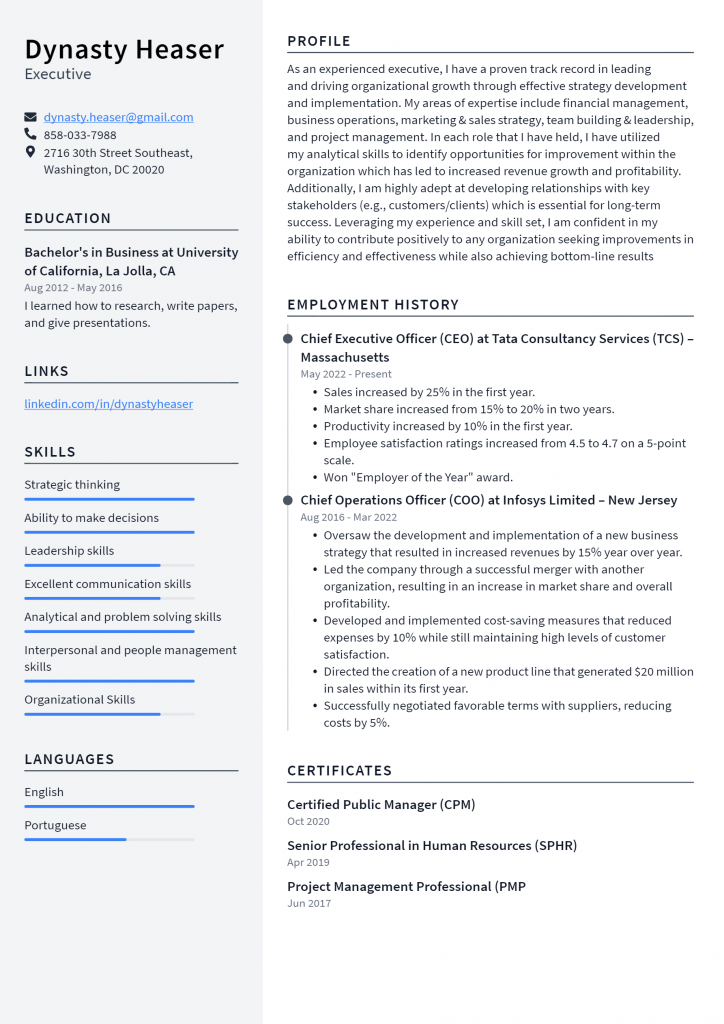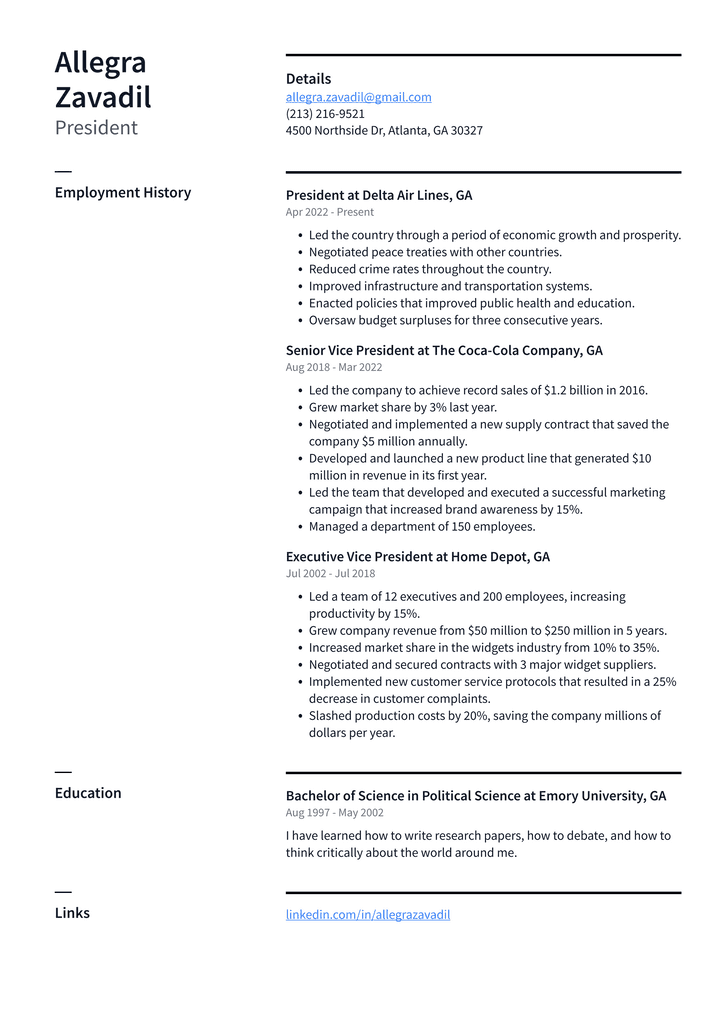Are you the type of person who thrives under pressure? Do you have a natural inclination to lead and influence others? If so, you may be ready to take your career to the next level with executive resume services. A high-performance resume is essential for landing top executive positions. Competition is fierce, and organizations are looking for proven performers – not just someone who has held various entry-level positions. In other words, if you want to break into the executive level, your resume must stand out from all the other applicants. On the other hand, if you’ve been working in an entry-level position for some time now and are ready for new challenges and responsibilities, it’s time to prove it with an executive resume. This article will walk you through how to create an impressive resume demonstrating your readiness for this step in your career.
Executive Resume Example

Download This Executive Resume as PDF
Executive Vice President (EVP) Resume Example
-resume-example-Nmg7o-724w.png)
Download This Executive Vice President (EVP) Resume as PDF
Chief Financial Officer (CFO) Resume Example
-resume-example-A1JCo-724w.png)
Download This Chief Financial Officer (CFO) Resume as PDF
Senior Vice President (SVP) Resume Example
-resume-example-6KkkY-724w.png)
Download This Senior Vice President (SVP) Resume as PDF
Chief Executive Officer (CEO) Resume Example
-resume-example-Uz7GA-724w.png)
Download This Chief Executive Officer (CEO) Resume as PDF
Chief Operating Officer (COO) Resume Example
-resume-example-EWhx6-724w.png)
Download This Chief Operating Officer (COO) Resume as PDF
President Resume Example

Download This President Resume as PDF
What is an Executive Resume?
A resume is a marketing tool that summarizes your career experience, educational background, and transferable skills. It should be as concise as possible and communicate your value to potential employers. An executive resume is a specialized type of resume used by high-level professionals to highlight their experience and prepare for promotion. The requirements for the resume vary depending on the industry and the position, but generally, the executive resume is longer than a standard one.
An Introduction to Resume Writing
The first step in writing an executive resume is understanding the various resume formats. There are many different ways to arrange a summary, and it’s essential to pick one appropriate for your industry and experience level. If you’ve never written a resume before, starting with a general resume format and modifying it as you gain more experience is helpful. This way, you’ll have a reliable resume template to fall back on whenever you need a new resume. The next step is to make a list of your career accomplishments. This content goes into the “what” and “why” sections of your resume. Include your professional goals, too – this will help you stay focused as you write your resume.
Defining the Executive Summary
An executive resume includes an executive summary, but it’s not the same as a standard summary that most job seekers have on their resumes. Instead, the executive summary briefly overviews your professional background and career goals. This section should be at the top of the resume and one or two paragraphs. It should include all the information that an executive would find valuable – your career goals, significant accomplishments, and any transferable skills you want to showcase. This is your opportunity to highlight your value to an executive recruiter without overwhelming them with details.
The Resume’s Core Content
The next step is to write the core content of your resume. This includes your professional profile, work experience, education, and transferable skills. It’s okay to modify the order of these sections to make them flow naturally, but try to keep them in the same general order as a standard resume. This section is where you will want to focus on your accomplishments. Highlight your leadership roles, hire ability, and other skills that make you the best candidate for the job. If there are any awards or recognitions that you’ve received, this is also the place to put them, along with any special projects or initiatives you’ve led.
The Professional Profile
The professional profile is a description of your skills, background, and educational and career history. It’s important to highlight all of the relevant skills to the position you’re applying for, such as management experience, leadership skills, and computer skills. This section is also a great place to put your languages and cultural competencies. An entry-level resume focuses on transferable skills, such as problem-solving, communication, and organization. As you move into the executive level, you want to focus on more specialized skills, such as profitability, cost savings, and leadership. Be sure to include quantitative data, such as the revenue generated, hours saved, and percentages increased, whenever possible.
The Resume’s Supporting Content
After highlighting your core qualifications, it’s time to include some supporting content. These sections include details about your education, work experience, and transferable skills. You can also have a list of honors, awards, and achievements. While these details are essential, don’t forget to proofread your resume. It’s easy to get too caught up in adding accomplishments and forget to check for spelling and grammatical errors.
Wrapping up
If you’ve worked in an entry-level position for a few years, it’s time to upgrade your resume. An executive resume is longer and more detailed than a standard one and focuses on your skills and accomplishments. An executive resume should include your professional profile, work experience, education, and transferable skills. You should also include a professional summary that highlights your career goals. Finally, ensure to proofread your resume for any grammatical or spelling mistakes once you’ve written an executive resume that communicates your value.